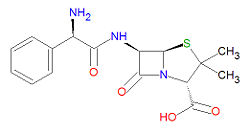Ampicillin: Difference between revisions
imported>David E. Volk (→Synonyms of ampicillin: two columns) |
imported>David E. Volk |
||
| Line 26: | Line 26: | ||
== Synonyms of ampicillin == | == Synonyms of ampicillin == | ||
{{col-begin}} | {{col-begin}} | ||
{{col-break|width= | {{col-break|width=25%}} | ||
* Ampicilline | * Ampicilline | ||
* Ampicillinum | * Ampicillinum | ||
| Line 36: | Line 36: | ||
* Ampicillin Base | * Ampicillin Base | ||
{{col-break|width= | {{col-break|width=25%}} | ||
* Ampicillin Anhydrous | * Ampicillin Anhydrous | ||
Revision as of 13:43, 3 April 2008
|
| |||||||
| ampicillin | |||||||
| |||||||
| Uses: | antibiotic drug | ||||||
| Properties: | beta-lactam | ||||||
| Hazards: | see drug interactions | ||||||
| |||||||
Ampicillin, or aminobenzylpenicillin, is a broad spectrum antibiotic and a derivative of penicillin. It is used to treat infections of E. coli, P. mirabilis, enterococci, Shigella, S. typhosa and other Salmonella, nonpenicillinase-producing N. gononhoeae, H. influenzae, staphylococci, and streptococci including streptoc. It is also widely used in molecular biology labs during the over-expression of proteins in bacterial cells that are tolerant of ampicillin. This ensures that only the bacteria of interest grow in the media and produce the protein of interest.
Ampicillin is a penicillin beta-lactam antibiotic used to eliminate susceptible, usually gram-positive, organisms. Like penicillin, ampicillin inhibits the last stage of bacterial cell wall synthesis by binding to specific penicillin-binding proteins in the bacterial cell wall.
Its IUPAC chemical name is (2S,5R,6R)-6-[[(2R)-2-amino-2-phenylacetyl]amino]-3,3-dimethyl-7-oxo-4-thia-1-azabicyclo[3.2.0]heptane-2-carboxylic acid and it has chemical formula C16H19N3O4S, giving it a molecular mass of 349.4048 g/mol.
Synonyms of ampicillin
|
|
Brand names of ampicillin
|
|
|
|
External links
- Ampicillin - FDA approved drug information (drug label) from DailyMed (U.S. National Library of Medicine).
- Template:MedMaster
- Template:DrugBank
